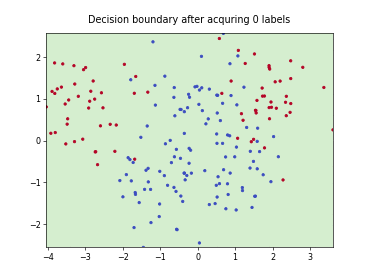skactiveml.pool.CoreSet#
- class skactiveml.pool.CoreSet(missing_label=nan, random_state=None)[source]#
Bases:
SingleAnnotatorPoolQueryStrategyCore Set
This class implement a core-set based query strategies, i.e., the standard greedy algorithm for the k-center problem [1].
- Parameters
- missing_labelscalar or string or np.nan or None, default=np.nan
Value to represent a missing label
- random_stateNone or int or np.random.RandomState, default=None
The random state to use.
References
[1] O. Sener und S. Savarese, “Active Learning for Convolutional Neural Networks: A Core-Set Approach”, ICLR, 2018.
Methods
Get metadata routing of this object.
get_params([deep])Get parameters for this estimator.
query(X, y[, candidates, batch_size, ...])Query the next samples to be labeled
set_params(**params)Set the parameters of this estimator.
- get_metadata_routing()#
Get metadata routing of this object.
Please check User Guide on how the routing mechanism works.
- Returns
- routingMetadataRequest
A
MetadataRequestencapsulating routing information.
- get_params(deep=True)#
Get parameters for this estimator.
- Parameters
- deepbool, default=True
If True, will return the parameters for this estimator and contained subobjects that are estimators.
- Returns
- paramsdict
Parameter names mapped to their values.
- query(X, y, candidates=None, batch_size=1, return_utilities=False)[source]#
Query the next samples to be labeled
- Parameters
- Xarray-like of shape (n_samples, n_features)
Training data set, usually complete, i.e. including the labeled and unlabeled samples
- yarray-like of shape (n_samples, )
Labels of the training data set (possibly including unlabeled ones indicated by self.missing_label)
- candidatesNone or array-like of shape (n_candidates), dtype = int or
- array-like of shape (n_candidates, n_features), optional (default=None)
If candidates is None, the unlabeled samples from (X,y) are considered as candidates If candidates is of shape (n_candidates) and of type int, candidates is considered as a list of the indices of the samples in (X, y). If candidates is of shape (n_candidates, n_features), the candidates are directly given in the input candidates (not necessarily contained in X).
- batch_sizeint, optional(default=1)
The number of samples to be selects in one AL cycle.
- return_utilitiesbool, optional(default=False)
If True, also return the utilities based on the query strategy
- Returns
- query_indicesnp.ndarray of shape (batch_size)
The query_indices indicate for which candidate sample a label is to queried, e.g., query_indices[0] indicates the first selected sample. If candidates in None or of shape (n_candidates), the indexing refers to samples in X. If candidates is of shape (n_candidates, n_features), the indexing refers to samples in candidates.
- utilitiesnp.ndarray of shape (batch_size, n_samples) or
- numpy.ndarray of shape (batch_size, n_candidates)
The utilities of samples for selecting each sample of the batch. Here, utilities means the distance between each data point and its nearest center. If candidates is None or of shape (n_candidates), the indexing refers to samples in X. If candidates is of shape (n_candidates, n_features), the indexing refers to samples in candidates.
- set_params(**params)#
Set the parameters of this estimator.
The method works on simple estimators as well as on nested objects (such as
Pipeline). The latter have parameters of the form<component>__<parameter>so that it’s possible to update each component of a nested object.- Parameters
- **paramsdict
Estimator parameters.
- Returns
- selfestimator instance
Estimator instance.
